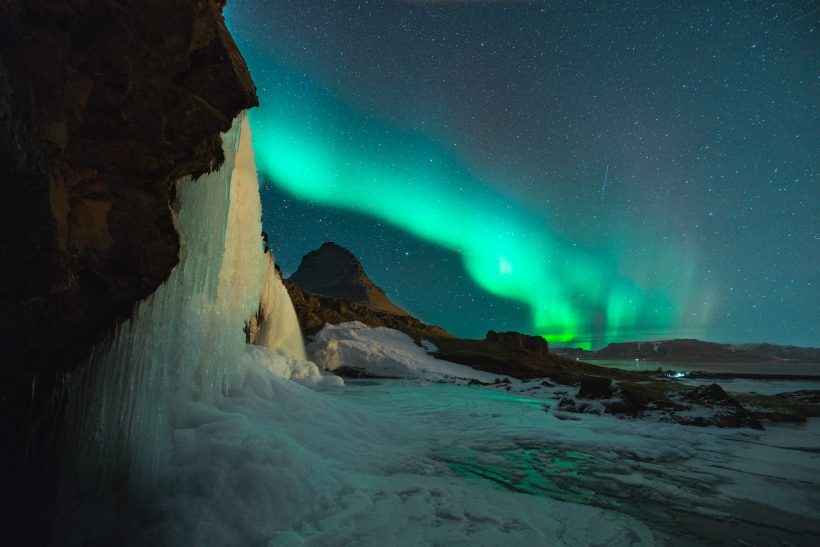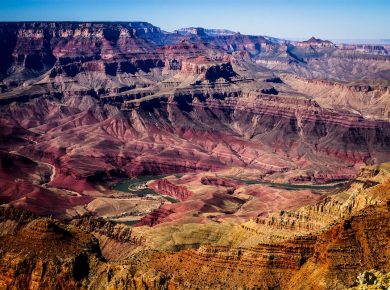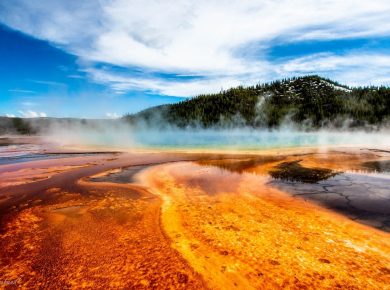Nestled in the northernmost corner of western Europe and across the ocean, Iceland is a mystery to many. However, it’s also one of the hottest tourist destinations in the world, offering visitors a wide range of activities, sights, and once in a lifetime attractions.
This is precisely why so many tourists choose Iceland as their travel destination each year. That being said, there’s a lot you need to know about Iceland before you decide when you want to visit. There’s a lot that goes into researching a destination before planning a trip, and one of the most important considerations is what month of the year you want to go.
Early September is our recommendation for the best month to visit Iceland, as you can still enjoy relatively warm weather with reduced prices for hotels and airfare.
If you don’t know much about Iceland, you may think it’s all snow and ice the whole year round, given its name and its northerly geographic location. But this isn’t true! While it’s true that Iceland does experience severe cold in the winter months, there are also plenty of times during the year where the weather is on the nicer side.
So, that begs the question, which is the best month to visit Iceland? In this article, we’re going to provide an in depth look at all the different aspects of which is the best month to visit Iceland, including the average temperature during the year, daily chance of precipitation, humidity levels, and much more.
Keep reading now to learn everything you need to know about when you should visit Iceland.
Table of Contents
Average Temperature In Iceland
When deciding which month of the year to visit any given location, it may be a good idea to know the average temperature before you go. The average temperature of a city or country can tell you a lot about when you may want to visit, such as which months are likely to be too cold or too hot for your preferences.
The average temperature in Iceland will vary throughout the year, differing largely depending on the month. If you’re looking for warmer weather, you may not want to travel to Iceland! Even in the hottest months of the year, July and August, you can expect an average temperature high of only around 56 degrees Fahrenheit and a low of 48 or 47 degrees Fahrenheit.
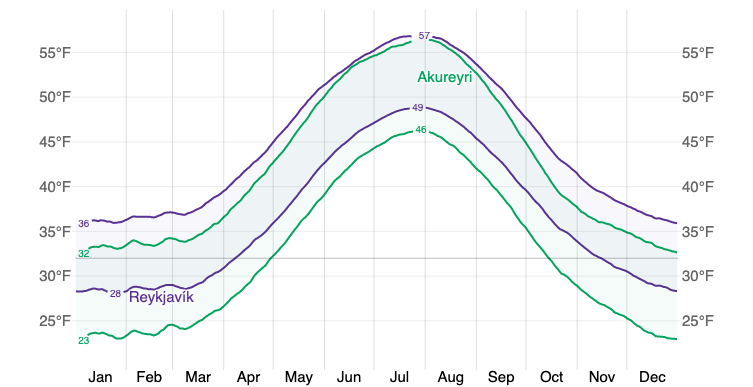
So for those of you who detest the heat and prefer cooler temperatures, Iceland is the perfect vacation destination for you! If you prefer it even colder than the temperatures of the summer months, you can expect an average high of around 35 degrees in the winter months of January and February.
The average lows for these months come in at around 28 degrees Fahrenheit. As you can see, Iceland lives up to its name! Such low average temperatures means this is certainly not a beach destination unless you like it chilly!
Daily Chance Of Precipitation In Iceland
Chance of precipitation is another major consideration when planning a trip to another country, as rain and snow can quickly ruin your plans if you didn’t plan for it. That’s why it’s a good idea to know when it’s likely to be raining or snowing and when the dryer months of the year are going to be before traveling.
In Iceland, the chance of precipitation rarely reaches higher than 50% on average. The months with the highest daily average chance of precipitation are the winter months, specifically January and February. You can expect a chance of around 55% during these months, meaning it’s a little more likely than a 50/50 chance of raining or snowing during these months.
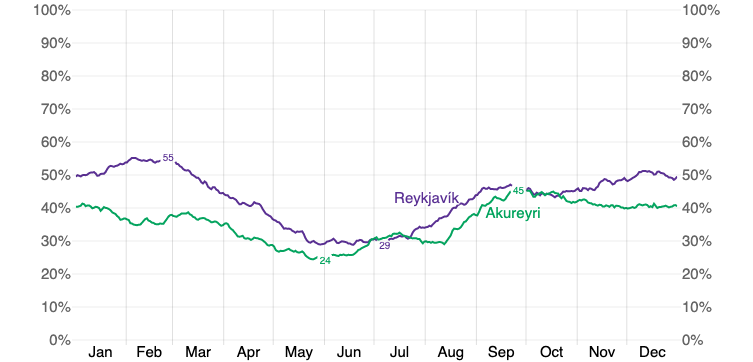
If you’re looking for a dryer season, then you’ll want to plan your trip to Iceland during the early summer months. The average daily chance of precipitation during the months of May through July falls between around a 25% chance and a 30% chance. Even though August is one of the warmer months of the year, the chance for precipitation climbs to around 35% to 40%.
Humidity Comfort Levels In Iceland
If you hate humidity and muggy days, then you’re in luck! It appears that Iceland is one of the least humid tourist destinations you could pick, with an average of 0% humidity throughout the entire year.
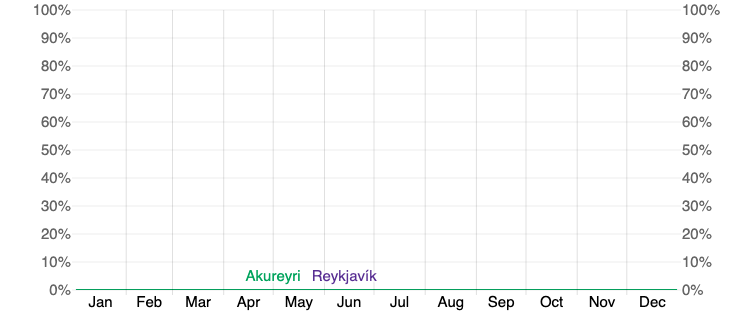
That’s right, that means no muggy hot days with your clothes sticking to your skin or your hair frizzing up because of the humidity. Iceland is a dry and temperate location, making it ideal for hiking and other outdoor attractions. You won’t have to worry about being soaked in sweat the second you hit the trails or the mountain ranges!
Best Time Of Year To Visit Iceland For Great Weather
Most tourists are looking for clear, rainless days when they plan their next vacation. We’re sure you’re no different, so let’s take a look at the best time of year to visit Iceland if you’re looking for the best weather.
According to the tourism score (which favors clear, rainless days with temperatures between 65 degrees and 80 degrees), the best time of year for great weather is the end of July into the beginning of August.
You can expect the most temperate weather with warm sunny days during this brief window. The score is also relatively high starting in June and ending at the end of August.
If your aim in your next vacation is to have a nice trip relaxing at the pool or beach, Iceland is not the destination for you! While it has some great weather for simply walking or enjoying destinations around the cities, it never gets warm enough for poolside activities. You could always try, of course, but it may not be a very enjoyable experience.
Best Time Of Year To Visit Iceland For Low Prices
For those who may be working on a budget and don’t want to spend above a certain amount for their vacation, they would be interested to know which part of the year has the lowest prices for tourism.
As with the majority of tourist destinations, the summer months are going to be the priciest for travel, along with the holiday season. So if you’re wanting to cut back on the spending for your trip to Iceland, you may want to plan around these times.
The cheapest months of the year to visit Iceland are going to be in the late winter months to mid spring, so February through April. Then after the warmer summer months have passed, it will be cheaper again during the late summer and fall, from September to early November.
Of course, if you travel to Iceland during the off season (which are the cheapest seasons of the year), then some tourist attractions may not be in operation or may have limited operating hours.
During the busiest times of the year is when you can expect to find the most things to do, though then you’d have to deal with higher prices for hotels, airfare, and other expenses along with heavy crowds. In the end, it’s up to you to decide whether or not the drawbacks of cheaper times of the year are worth it for your trip.
When Should You Go To Iceland?
Peak Travel Season In Iceland
Many tourists prefer to travel during peak season, which is the busiest time of the year for any given tourist location. Depending on specific locale, the peak season usually falls somewhere in the summer months when the weather is considered to be nicest.
Iceland is no different in that regard, as peak season for travel to Iceland falls on July and August each year. This is when the country is its warmest, which is to say, it’s still not that warm compared to most other countries during the same months.
As we mentioned earlier, you’re not going to find much beach or poolside activity here, as even during the peak season it’s relatively cool outside. Peak season offers the most varied range of activities to plan for, as this is when all tourist attractions will be open to catch the peak season rush.
This does mean, however, that you’ll be dealing with large crowds in some areas, as well as higher prices. You can expect to pay much more for hotels and airfare during the peak season when traveling to another country.
Shoulder Travel Season In Iceland
The shoulder season for any given tourist destination falls on the months directly prior to peak season and directly after. So for Iceland, the shoulder season would typically be the spring months and the fall months, respectively. Specifically, this is March through May and September through November.
One major contributing factor to the shoulder season is the typical school year. For much of the world, school runs from September to early summer, usually ending in May or June. This affects the availability many families have for travel and limits them to traveling only during the peak season summer months.
This is another reason why peak season is so busy because this is generally when people have more time and flexibility for travel. Pricing for shoulder season is going to be cheaper than during the peak season, especially for hotels and airfare.
You’ll also notice a lot less people around certain tourist attractions, even if some of them will be closed or operating under reduced hours. This is common for some tourist attractions, as they only have funding to operate normally during the busier peak season months.
Low Travel Season In Iceland
The off season falls on those months of the year that attract the least amount of tourists. This will typically be the coldest or rainiest months of the year for most tourist destinations. This is the same for Iceland, too, as the months of December through February belong to the off season.
This is the coldest time of the year, with temperatures falling much lower than most people are comfortable in. Throw tons of snow and ice on top of the biting cold, and you start to understand why these months are considered Iceland’s off season.
This is the perfect time to visit Iceland if you’re looking for the cheapest hotels and airfare, and many tourist accommodations will even be running deals and sales to offset the lack of tourist traffic. If you’re working with a tighter budget for your Iceland trip, you may want to consider traveling there during these months.
You’ll be sure to save a ton of money by doing so! This is also a great season to visit Iceland if you enjoy certain winter sports like skiing or snow hiking. Iceland boasts some of the world’s best winter views, with sweeping snowy mountain vistas and rolling icy fields. Just remember to pack a lot of warm clothing and winter supplies!
Best Months For Travel To Iceland
Taking into account all the information we’ve just explained to you, which month is the best month for visiting Iceland?
We would say it’s best to visit Iceland during the peak season, as this is the time of year with the best weather. It’s warm enough that you won’t be freezing as you go on hikes, enjoy the outdoor scenery, or visit the various city attractions in some of the largest cities in Iceland like Reykjavik.
Early September is our specific recommendation, as you can still enjoy relatively warm weather with reduced prices for hotels and airfare. Most of the tourist attractions and accommodations will still be running like normal, and you won’t have to deal with quite as many other tourists crowding the streets.
